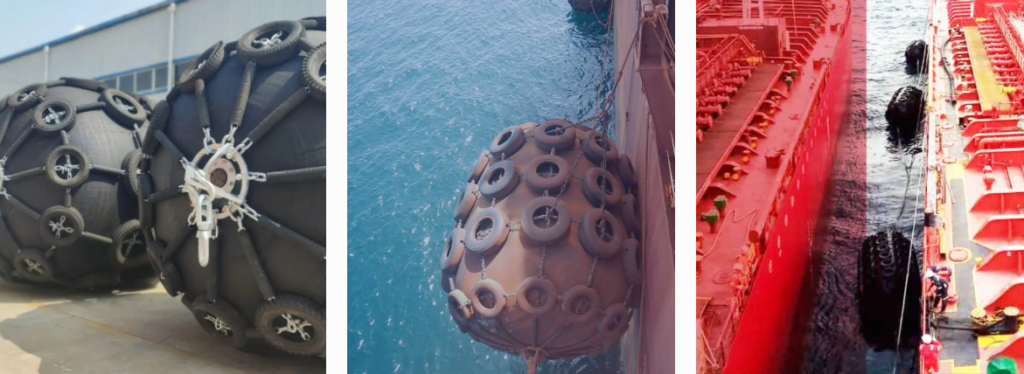Why Choose Donut Fenders for Monopile Protection Systems?
07/01/2025How to store rubber fenders?
07/02/2025Cell Fenders vs. Pneumatic Fenders: Which One Is Right for You?
1. Why This Matters — And Why Now
Collision incidents and rising maintenance costs are forcing ship and port operators to rethink fender choices. Imagine a busy cruise terminal in San Francisco, where tidal shifts and high traffic intensify demand on marine fenders. Choosing the wrong option—say, a cell fender ill-suited to constant movement—leads to premature wear, costly replacements, and operational delays. With budgets tight and downtime expensive, selecting the right marine fenders and ship fenders is urgent.
2. Quick Comparison at a Glance
Cell Fenders: Rubber cylinders with hollow chambers—excellent energy absorption and low reaction force, ideal for heavy-duty berths.
Pneumatic Fenders: Inflatable Yokohama-type units—adaptable, float freely, affordable short term, perfect for STS and variable tides.
3. Deep Dive into Each Type
Cell Fenders: Heavy-Duty, High-Energy Absorption
- High performance & durability: Cell fenders boast “superior energy absorption and low reaction forces,” making them ideal for oil terminals, container ports, and LNG operations.
- Low hull pressure: Their hollow-cell design offers uniform load distribution across the hull and berth.
- Robust build: Resistant to weather, UV, and abrasion—ideal for permanent installations.

Pneumatic Fenders: Flexible & Cost-Effective
- Portable and easy to deploy: Inflate/deflate with ease, ideal for temporary docking or emergency berths.
- Soft reaction force, STS‑friendly: Excellent cushion during ship-to-ship transfers and major tidal shifts.
- Economic: Typically around ⅓ the cost of foam or cell units for the same size.

4. Pros & Cons at a Glance
| Feature | Cell Fender | Pneumatic Fender |
|---|---|---|
| Energy absorption | Very high, ideal for heavy berthing | High, but slightly less efficient per size |
| Reaction force | Low and consistent | Very low at light loads; increases under load |
| Durability | Excellent, long service life | Good, but vulnerable to puncture |
| Maintenance | Visual checks; rarely serviced | Annual inflation checks; repair punctures |
| Initial cost | Higher upfront investment | Cost-effective |
| Portability | Fixed installation | Easily transportable and reusable |
5. Which Should You Choose?
Choose Cell Fenders if you need:
- Long-term installations at busy terminals
- Handling large vessels (bulk, container, oil)
- Minimal hull pressure and consistent performance
Opt for Pneumatic Fenders if you want:
- Flexibility for ship-to-ship ops or emergencies
- Affordable short-to-mid-term solution
- Quick-deployment options for changing tidal conditions
6. Wrap-Up
Selecting the right ship fenders or marine fenders boils down to operational needs. Choose cell fenders for robustness and performance in permanent setups; go with pneumatic fenders for cost-effective flexibility and portability. NANHAI specializes in both—ready to help you match the perfect solution to your dock’s demands.
FAQ
1. What are marine fenders used for?
Marine fenders protect boats, ships, and port infrastructure by absorbing and dissipating kinetic energy during berthing, preventing damage to both hulls and structures.
2. Are cell fenders better than pneumatic fenders?
Cell fenders excel in fixed installations, handling heavy vessels with high energy absorption and low reaction force. Pneumatic fenders offer flexibility, portability, and lower cost—ideal for ship-to-ship operations and tidal variations.
3. How do pneumatic (Yokohama) fenders work?
They absorb impact via compressed air in a rubber body. Their low reaction force at light deflection makes them ideal for liquid cargo operations and STS transfers.
4. What is the lifespan of cell fenders?
Fixed cell fenders typically last between 10 to 20 years, depending on berthing frequency and environmental exposure.
5. Can cell and pneumatic fenders be used together?
Yes—they are often combined: cell fenders for permanent docking, with pneumatic fenders added for flexible, temporary, or ship-to-ship operations.
Let me know if you’d like further info on marine fenders, ship fenders, or solutions from NANHAI!
